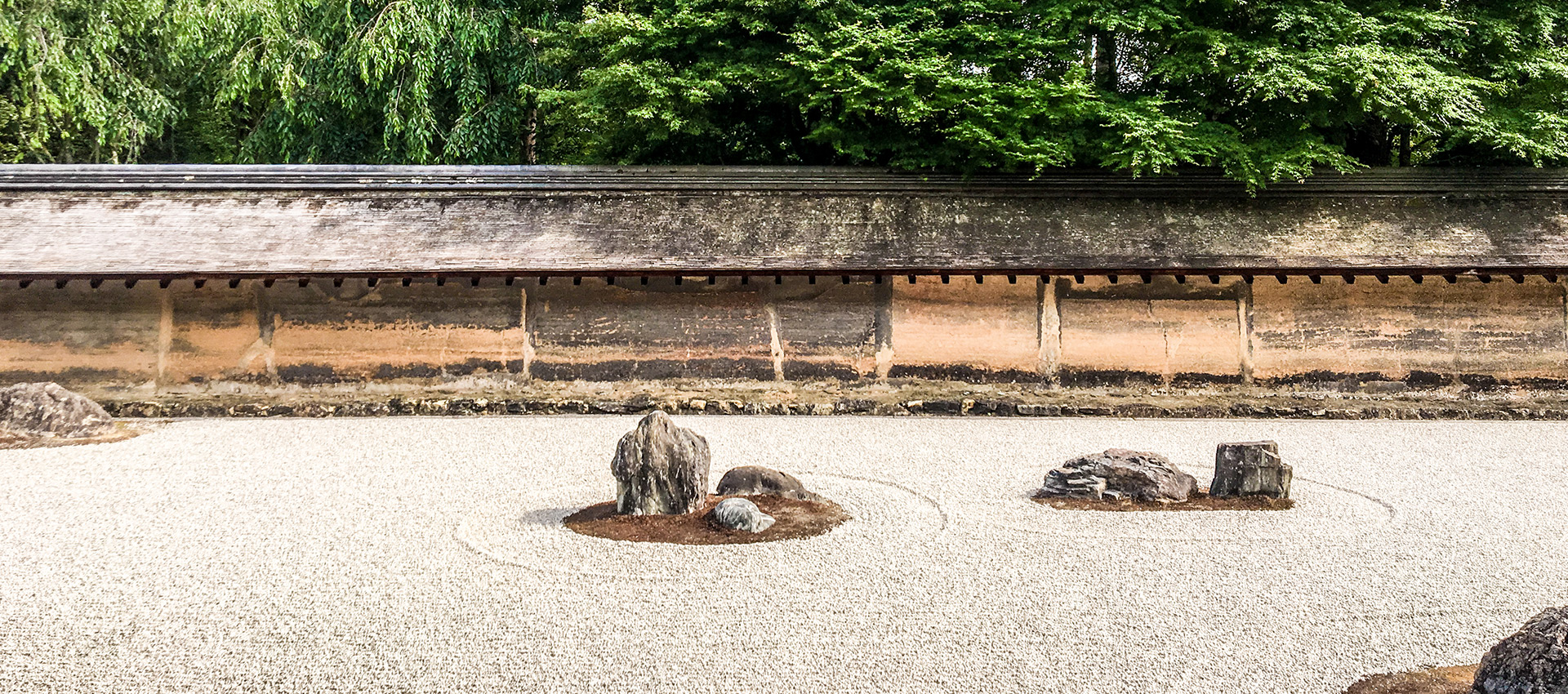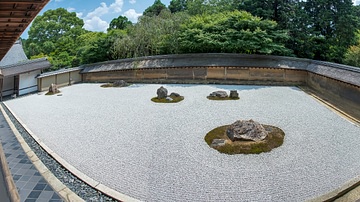Overview
Kyoto, Japan; Muromachi Period, Japan; C. 1480 CE; Current design most likely dates to the 18th century; Rock garden; Form. Zen Buddhism temple; A complex of 23 sub-temples. This site uses cookies to deliver our services, improve performance, for analytics, and (if not signed in) for advertising. By using LibraryThing you acknowledge that you have rea.
Ryōan-ji is home to one of Japan’s most famous rock gardens, a cultural heritage site that attracts visitors from all around the world every day. Originally the temple was an aristocrat’s villa during the Heian Period, but it was converted into a Zen temple in 1450 by Hosokawa Katsumoto, who was a top-ranking warlord in the Ashikaga Shogunate. Although the rock garden at Ryōan-ji takes the spotlight, the temple offers other beautiful gems such as the Kyōyōchi Pond in its residential-style leisure garden, as well as the beautiful paintings and artifacts in the Abbot's Quarters. In 1994, this temple was designated as a World Heritage Site by UNESCO.
Ryōan-ji is home to one of Japan’s most famous rock gardens, a cultural heritage site that attracts visitors from all around the world.
Features
Zen Rock Garden
The rock garden at Ryōan-ji, a piece of Japanese cultural heritage, is arguably the most popular in Kyoto. The deceptively simple garden consists of fifteen rocks spread out on white sand in a space of 248 square meters. The fifteen rocks are carefully arranged so that there is always at least one rock that cannot be seen, regardless of the angle. The garden was likely built in the Muromachi period (late 14th - 16th century), but who built the garden still remains a great mystery. Along with the confusion surrounding who designed it, the intended meaning of the garden is unclear and theorists have interpreted the garden in many different ways. One of the more popular theories is that the garden shows a tiger carrying her baby cubs across the water, while another theory is that the rocks spell out the Chinese character “heart”.
Tsukubai Water Basin

This interesting and rather philosophical stone water basin sits in the rear garden opposite the stone garden. Water basins like this are usually used by guests to cleanse their mouths and hands before entering a teahouse. The Zōroku-an teahouse is where the original basin lies, but here all tourists can take a look at a replica without needing to take part in a ceremony. Instead of the more common round shape, this tsukubai has a square basin that represents a particle used to complete the four Chinese characters on each side of it. Reading the kanji with the “□” included each gives you “ware tada taru wo shiru”. It means, “I only learn to be content”, or “I am content with what I am”.
Kyōyōchi Pond
Below the temple’s main building you will find a spacious strolling garden and a pond called the Kyōyōchi Pond. In the past, this pond was also called the Oshidori Pond, oshidori being the Japanese word for “mandarin ducks”, which used to winter in the area. A great place for a relaxing walk, it’s especially beautiful in autumn as the surrounding trees turn red, yellow and orange. The garden is a “stroll-style” garden, and the pond remains from the Heian period when the land was an aristocrat’s villa used for pleasure boating.

History
Like many Buddhist temples, Ryōan-ji began its life as a private estate. Belonging to the Fujiwara family, one of the most influential political clans in the Heian period, the first temple to be built on the site was founded in 983 and called Enyū-ji for the memorial tomb of Emperor En’yū.
Over time Enyū-ji fell into ruin and in the 12th century the land came under the stewardship of Fujiwara Saneyoshi, who built a villa on the property. This eventually passed into the hands of Hosokawa Katsumoto (1430-1473), a powerful deputy to the shogun Ashikaga Yoshimasa, in 1450. Hosokawa converted the villa into the Zen temple Ryōan-ji, and the 5th abbot of nearby Myōshin-ji, Giten Genshō, was invited to be the temple’s founder.
Unfortunately, Hosokawa later became embroiled in conflict with Yamana Sōzen over the issue of the succession of the Ashikaga Shogunate. The Ōnin War engulfed Kyoto in 1467, taking with it Ryōan-ji and many other temples and shrines destroyed by fire and conflict. Ryōan-ji lay in ruins until Hosokawa’s son, Hosokawa Masamoto, rebuilt it. Ryōan-ji’s cemetery contains the graves of Hosokawa Katsumoto, his wife, his son, and the founder’s.
Ryōan-ji is also the location of the “Seven Imperial Tombs”, home to the mausoleums of seven imperial family members: Emperors En’yū, Ichijō, Go-Suzaku, Go-Reizei, Go-Sanjō, and Horikawa, as well as Imperial Princess Teishi. Though these were modest plots in the past, they became larger as of the 19th century restoration of imperial sepulchers (misasagi) undertaken by Emperor Meiji. 1797 saw fire destroy parts of Ryōan-ji once more, but the damaged Abbot’s Quarters were soon replaced with a building transferred in.
When it comes to the temple’s garden history, however, things are much less clear. Some say it was built by one of the Hosokawa, while others claim that it was the work of the famous monk Sōami. Others claim the work was done by professional gardeners of the kawaramono class rather than monks. As for the date of construction, more recent thought tends towards believing the garden was placed in the 17th century, as no mention of a garden can be found in records before that time. Akisato Ritō, poet, writer, and garden designer of the 18th century, featured Ryōan-ji’s garden in his 1799 book Celebrated Gardens and Sights of Kyoto, which has been used to prove that there has been no change to the garden’s design since that time.
These days this Zen style garden is one of the most famous in Kyoto, even Japan, and draws large amounts of visitors who wish to take a seat and look over the raked sand searching for meaning within the design.
Access
Address
〒616-8001 京都市右京区龍安寺御陵下町13


| TEL | 075-463-2216 |
| FAX | 075-463-2218 |
| WEB | http://www.ryoanji.jp/top.html |
Admission
- General Admission: ¥500
- Junior High School, Elementary School: ¥300
Hours

- General Admission: 08:00 – 17:00 (March – November), 08:30 – 16:30 (December – February)
- Closed: No closing days
Transportation
Zen Garden Kyoto Japan
- From Kyoto Station ⇒ City Bus Route 50 ⇒ Ritsumeikan Daigaku-mae Bus Stop ⇒ 7 minutes walking
- By Hankyū Railway ⇒ Omiya Station ⇒ City Bus Route 55 ⇒ Ritsumeikan Daigaku-mae Bus Stop ⇒ 7 minutes walking
- By Keihan Railway ⇒ Sanjō Station ⇒ City Bus Route 59 ⇒ Ryōanji-mae Bus Stop
- By Keifuku Kitano Line (Randen) ⇒ Ryōanji Station ⇒ 7 minutes walking
Ryoanji Temple
Gallery
